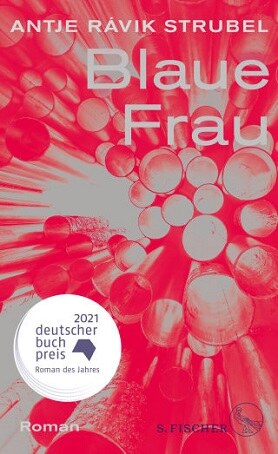Fiction
Translation Grant Programme
Published in Italian with a grant from Litrix.de.
Resisting the cynicism of power
It’s the mood that strikes readers immediately. In her novel Blue Woman, Antje Rávik Strubel creates a very special kind of suspense that continues from the very first page onwards. Her heroine, Adina, a young woman from the Czech Republic now living in Finland, has fallen into a deep hole and is terrified. Previously, she had been working illegally at a hotel bar in Helsinki before moving into her lover Leonides’ wooden house. Her present day refuge is a sparsely furnished apartment. There she gradually manages to face the event that had triggered her trauma. And as Adina listens to the sounds in the strange surroundings, a second narrative level comes into play. Marked by the first letter of the sentence, writ large and in boldface type, this storyline spans just a few sentences at first, and then increasingly takes up more and more space as the novel progresses. A first-person narrator intervenes in the story, a writer, not unlike the author, who is in the midst of writing a book. She first encounters the “blue woman” at the harbor in Helsinki. Seductive and mysterious, she seems to stoke the writer’s creative powers, while marking the space of fiction.
We slowly discover Adina’s story, whose past is revealed in fragments and then painstakingly recovered throughout the novel. In this way, the violence the young woman had suffered conveys itself all the more clearly. The childhood scenes from the Czech snowy village are peppered throughout the love story with Leonides, the Estonian diplomat and university professor, who has provided her with a breather in Finland.
Leonides is an amalgam of East and West, a man with a sophisticated mind and an advocate for a new culture of memory that would bring to light the “dark places” of Stalinism. Nevertheless, he lacks the sensorium for the plight of his own girlfriend. Adina, who already made an appearance in Antje Rávik Strubel’s early novel: “Unter Schnee” (2001) / “Snowed Under” (2007). She was born in 1984 and raised in a matriarchal household in Haarachov, a small town in the mountains, where for lack of kids her age, she had turned to the internet, naming herself “The Last Mohican,” a metaphor for being the last teenager in the slowly dying town.
In “Blaue Frau”, we follow Adina on her path to the reunified Germany of 2006, where she enrolls in a German language course in Berlin-Lichtenberg, and is taken in by a group of bohemian lesbians. Through them, the shy young woman discovers her inner Mohican, and lands an internship on an estate in the Uckermark region of Brandenburg with a vainglorious impresario named Razvan Stein. Stein is obsessed with building a hub for culture in the middle of the wasteland, and for that he needs a powerful multiplier, a person who can easily access government funding. This aptly drawn figure of Johann Manfred Bengel, old, but undaunted, wearing sneakers and always with a soft: “so nice, so nice” at the tip of his tongue, obviously doesn't have his sex drive under control. Flash forward, one year later in Finland, Adina accompanies Leonides to a reception, where she hears the sound of Bengel clearing his throat, an acoustic trigger that brings back a flood of memories of the sexual assault she suffered in the Uckermark, and which ultimately turns her life with Leonides upside down.
The temporal structure of “Blue Woman” is captivating. Antje Rávik Strubel skillfully uses the epic stylistic device of foreshadowing. Instead of lengthy flashbacks, there are short, abrupt plunges into the past. Often, memories seem to assail her heroine rather than allowing her to recall her experiences in detail. The four parts of the novel are tied to different main settings. An epigraph hints at the atmosphere of each time and place. Antje Rávik Strubel's command of her characters is just as masterful as the dramaturgy of her novel. And beyond that, she also provides insights into an idiosyncratic country caught between worlds, “Slavic soul, Scandinavian design,” as Leonides describes Finland. Antje Rávik Strubel’s narrative art becomes most impressive when she works with dissolves and double exposures, blurring contours and dissolving the coordinates of time and space.
In the final section of the book, Kristiina takes center stage of the story. She is a parliamentarian and activist, and Adina instinctively trusts her, especially given how completely free and autonomous the Finnish woman seems to her. “Blue Woman” tells a Harvey Weinstein story, while soberly offering a critical assessment of the power relations between men and women, which until just a few years ago had been considered sacrosanct. Even though Adina shies away from a showdown at the end, she does fight back. For all the violence done her, there is still something in her that has remained untouched.
By Maike Albath
Maike Albath is a literary critic and journalist for the radio stations Deutschlandfunk and DeutschlandRadioKultur. She also writes for the newspapers Neue Zürcher Zeitung and the Süddeutsche Zeitung. Her books “Der Geist von Turin” (2010) and “Rom, Träume “(2013) were published by Berenberg Verlag.


